From Manual to Smart: Pallet Inverters Transforming Malaysia's Material Handling
Manual material handling on the factory floor is a constant source of problems. It is slow, it is often dangerous, and it is surprisingly expensive. Many business owners I talk to are dealing with the daily headaches of damaged goods, potential worker injuries, and inefficient pallet management. In a competitive market like Malaysia, these issues directly impact the bottom line. You might see your team spending hours manually restacking products just to replace one broken pallet at the bottom. You worry about the risk of back injuries and the high costs that follow. This old, manual process creates bottlenecks that can slow down your entire supply chain. But there is a much better way. Smart pallet inverters offer a clear solution, automating this entire process to make it fast, safe, and incredibly efficient. They are a key piece of equipment in any modern material handling system.
Pallet inverters are transforming Malaysia's material handling by replacing slow, labor-intensive manual processes with a fast, automated solution for rotating, transferring, or inverting entire pallet loads. This automation significantly boosts efficiency, enhances worker safety by eliminating stressful manual lifting, and reduces product damage. The result is lower operational costs and a more streamlined, competitive supply chain.
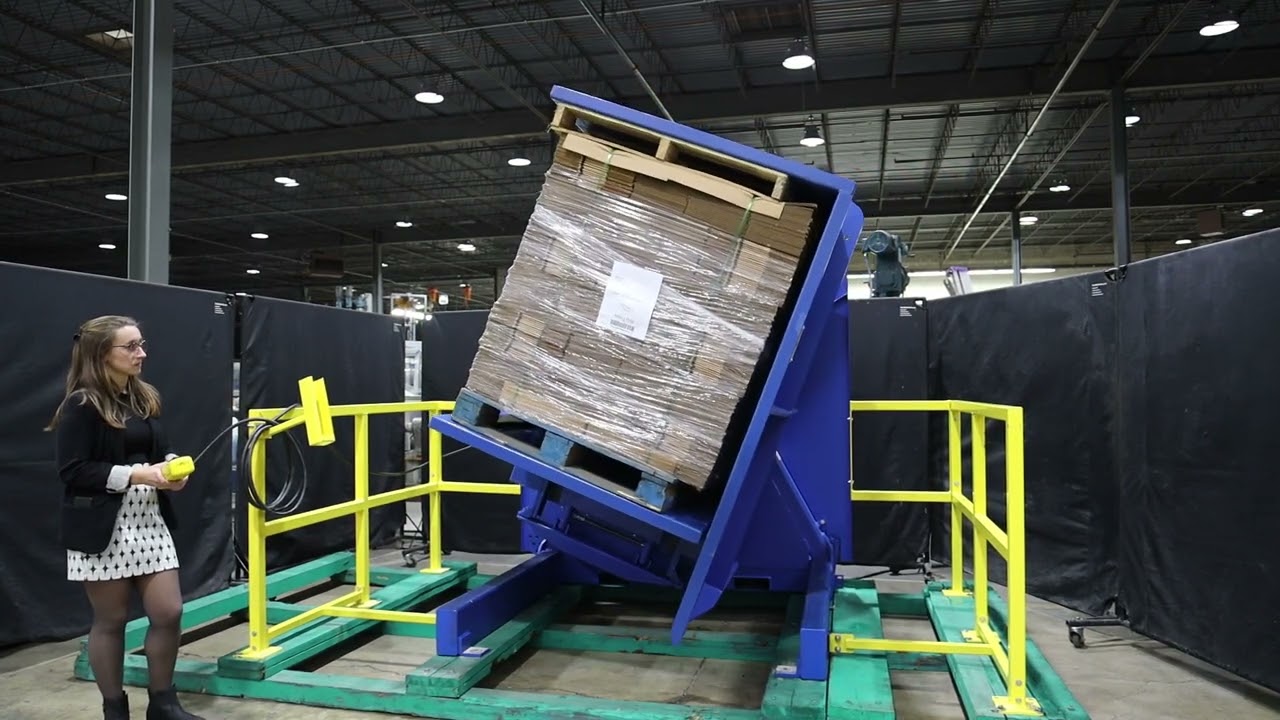
This all sounds good in theory. But what does this transformation really mean for a business owner on a practical, day-to-day level? I have spent my career designing, building, and watching these machines work in real-world factories. I want to share my direct experience from the ground up. Let’s break down exactly what these machines are and explore the specific reasons they are becoming so essential. We will look especially at why a dynamic and growing market like Malaysia is seeing such a rapid shift toward this technology.
What exactly is a pallet inverter and how does it work?
You often hear the term "pallet inverter," but it might sound complex or overly technical. Perhaps you picture a complicated piece of robotics that is difficult to understand. It is hard to justify a significant investment if you don't fully grasp the machine's core function and its direct benefits. This feeling of uncertainty can cause you to stick with old, inefficient methods. You continue to accept the high costs of manual labor and damaged goods because the "new" technology seems like a black box. In reality, a pallet inverter is built on a surprisingly simple and effective concept. Let me help demystify it for you. At its heart, it is a machine designed for one primary job: to safely grip and rotate a full pallet load.
A pallet inverter is a stationary machine that uses clamping plates to secure a palletized load, rotate it up to 180 degrees, and allow for the easy exchange of the pallet underneath. This simple action solves several common problems. It is used to replace damaged or broken pallets, switch from internal wooden pallets to clean plastic or export-compliant pallets, or recover damaged goods from the bottom of a stack without needing to manually unstack and restack the entire load.
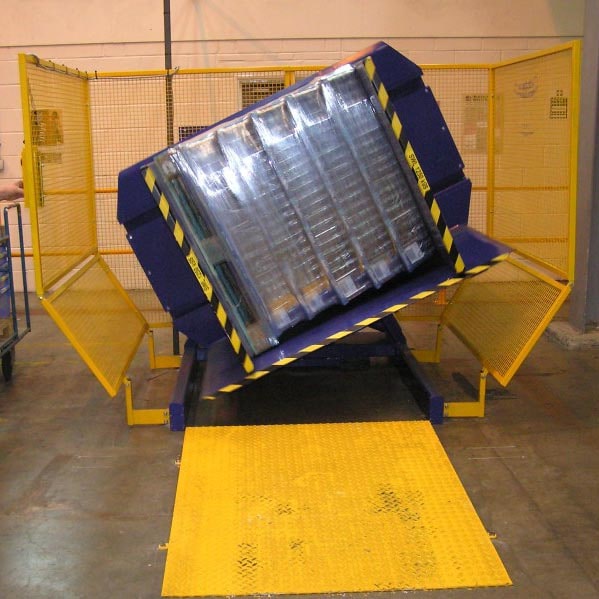
The Core Mechanical Process
The operation is straightforward. First, a forklift or pallet jack places the full pallet into the machine. The machine’s powerful clamping plates, usually powered by hydraulics, press in from the top and bottom to secure the load. It holds everything tightly so nothing shifts or falls. Once the load is secure, the entire chamber rotates, often a full 180 degrees. The pallet, which was on the bottom, is now on top. The machine's base then lowers or retracts, separating the old pallet from the goods. An operator can then easily remove the old pallet and place a new one on the load. Finally, the machine rotates back to its original position, and the load, now on a new pallet, is ready to be moved. The entire cycle takes only a minute or two.
Types of Pallet Inverters
Not all loads or operations are the same, so there are different types of inverters. Choosing the right one is key to getting the best results.
| Type | Mechanism | Best Use Case |
|---|---|---|
| 180° Inverter (Free-standing) | Clamps the load and flips it completely upside down. The most common type. | General purpose, replacing broken pallets, transferring goods between pallets. |
| 90° Tipper / Pallet Changer | Tilts the load 90 degrees onto its side, allowing goods to rest against a solid wall. | Ideal for sensitive, fragile, or unstable loads like bags, pails, or vials that cannot be fully inverted. |
| Inline Pallet Changer | Fully integrated into a conveyor line for hands-free automation. | Designed for high-volume operations like large distribution centers or bottling plants. |
My First Encounter with a Pallet Inverter
I remember the first time I saw one of these machines in action. It was in a steel wire factory many years ago. They were constantly fighting with moisture-damaged wooden pallets that were breaking and compromising the large, heavy steel wire coils. Manually transferring those coils from one pallet to another was a nightmare. It was slow, and it was dangerous for the workers. They installed a simple, free-standing 180° inverter. An operator could drive up with a damaged pallet, and in less than a minute, drive away with the same load on a brand new pallet. It was a revelation to me. It wasn't just about the incredible speed. It was about protecting their valuable product and, more importantly, protecting their people. This experience showed me early in my career that even a single, well-placed machine can have a massive impact on an entire operation. It proved that the best solutions are not always the most complex; they are the ones that solve a real, tangible problem effectively.
Why are Malaysian industries rapidly adopting pallet inverters?
Malaysia's manufacturing and logistics sectors are experiencing impressive growth. But this growth brings intense pressure to be more efficient and cost-effective than ever before. Relying on old manual methods for material handling is simply no longer a viable option if you want to stay competitive in the local or global market. Your competitors who embrace automation can process orders faster, reduce their costs, and ship products more reliably. If you stick to manual handling, you face higher labor costs, more frequent product damage, and slower turnaround times. These factors ultimately hurt your market position and your profitability. Malaysian business owners are smart and pragmatic. They see the clear return on investment. They are adopting pallet inverters not as a luxury item, but as a necessary and powerful tool to solve these specific challenges and fuel their continued growth.
Malaysian industries are rapidly adopting pallet inverters to address key economic and logistical pressures that are unique to the region's dynamic economy. These critical drivers include rising labor costs, a strong national focus on improving workplace safety standards, the need to meet strict international quality standards for export products, and the universal drive to increase overall supply chain efficiency to compete in the global marketplace.
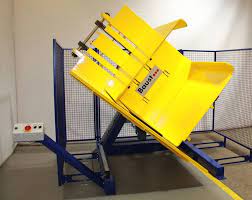
The Economic and Logistical Drivers
Labor costs in Malaysia are rising, and finding reliable workers for physically demanding jobs is becoming more difficult. Automation with a pallet inverter provides cost stability and predictability. Instead of relying on a team of workers for a manual task, one operator can manage the process efficiently. This frees up your valuable team members to focus on more skilled, value-added tasks. Furthermore, speed is everything in modern logistics, especially in a country with busy hubs like Port Klang and the Port of Tanjung Pelepas. A pallet inverter can be the difference between meeting a tight shipping deadline and facing costly delays. By turning a 30-minute manual task into a 2-minute automated one, you create a much more fluid and responsive supply chain.
Meeting Quality and Compliance Demands
Many Malaysian companies are major exporters to regions like Europe, North America, and Australia. These markets have very strict regulations. For example, the ISPM 15 standard requires that all wooden pallets be heat-treated or fumigated to prevent the spread of pests. Many food, beverage, and pharmaceutical industries also require products to be shipped on hygienic plastic pallets, not wood. A pallet inverter makes complying with these rules incredibly simple. I worked with a client in the food processing industry near Johor Bahru. They needed to switch from their internal wooden factory pallets to certified hygienic plastic pallets for all their export orders. Before, they had a team of four workers who would spend nearly half an hour manually re-stacking a single pallet. It was a huge bottleneck. After we helped them install a pallet changer, one operator could do the same job in under two minutes. Their compliance became effortless, and their labor costs for that task dropped significantly.
The Boom in E-commerce and Warehousing
Malaysia’s digital economy is booming, and this has led to a massive expansion in e-commerce fulfillment and modern warehousing. These facilities handle a huge volume of goods every single day. In such a high-speed environment, a single broken pallet can disrupt the entire flow of operations. Pallet inverters are essential for quickly managing damaged pallets, sorting incoming goods onto standardized in-house pallets, and preparing outbound shipments, ensuring that the warehouse runs smoothly and efficiently.
How do smart pallet inverters improve safety and reduce costs?
Workplace accidents and operational inefficiencies are two of the biggest hidden costs in any factory or warehouse. A single back injury from improper lifting can lead to lost workdays, expensive insurance claims, and a drop in team morale. At the same time, products that get damaged during manual handling eat directly into your hard-earned profits. You might start to think that these issues are just the unavoidable "cost of doing business." But every time a worker has to manually re-stack a heavy load, or every time a forklift accidentally damages a pallet full of goods, your bottom line takes a direct hit. Over a year, these small, frequent costs add up to a significant financial drain. Smart pallet inverters are engineered to tackle both of these problems head-on. They are designed with operator safety as a top priority and built to create a more efficient, less wasteful workflow.
Smart pallet inverters improve safety by automating the hazardous task of manual load handling, which drastically reduces the risk of common and costly musculoskeletal injuries for workers. They reduce operational costs in several ways: by minimizing product damage that occurs during pallet exchange, by lowering direct labor expenses, by speeding up handling processes, and by decreasing the frequency of workers' compensation claims.
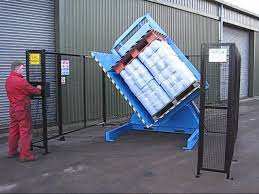
A Revolution in Workplace Safety
Let's be very clear about the risks of manual pallet handling. The primary danger comes from lifting heavy boxes or bags over and over again. This leads to back strain, shoulder injuries, and repetitive stress disorders. There is also the risk of items being dropped, causing foot injuries or damage to the product itself. A pallet inverter removes the worker from this danger zone almost completely. Modern machines are equipped with essential safety features like protective steel caging, light curtains that immediately stop the machine if a person enters the operating area, and easily accessible emergency stop buttons. The operator works from a safe distance, using simple controls.
I have seen the safety data from factories both before and after they installed a pallet inverter. The reduction in reported lifting-related incidents is always dramatic. For a business owner in a heavy industry like a steel mill, where loads are heavy and safety is absolutely paramount, this is a powerful argument. You are not just buying a machine to improve efficiency. You are making a direct investment in the health and well-being of your team, and you are actively reducing your company's liability and risk.
The Tangible Cost Savings
The return on investment (ROI) from a pallet inverter is clear and easy to calculate. Let's break down the savings in a simple table.
| Cost Area | Manual Process | With Pallet Inverter | Savings |
|---|---|---|---|
| Labor | 2 workers, 15-20 min/pallet | 1 worker, 1-2 min/pallet | High |
| Product Damage | ~3-5% damage from handling | <1% damage rate | Significant |
| Injury Claims | Constant risk, high potential costs | Risk is drastically reduced | Substantial |
| Pallet Costs | Broken pallets often discarded | Good pallets are saved; only bad ones replaced | Moderate |
The savings on labor are not just the salary. It is the opportunity cost. What else could those workers be doing to add value to your business? The cost of product damage is not just the value of the goods. It is the potential loss of a customer's trust if they receive a damaged shipment. A pallet inverter helps turn these variable, unpredictable costs into a fixed, predictable, and much lower operational expense. This is the kind of practical, bottom-line improvement that strengthens a business for the long term.
What should you look for when choosing a pallet inverter for your facility?
You are convinced that a pallet inverter could help your operation. That's a great first step. But when you start looking, you will find that the market has many different options from many different suppliers. Choosing the wrong machine can be a costly mistake. You could end up with a machine that doesn't fit your workflow, cannot handle your specific products, or breaks down frequently. A bad purchase is often worse than making no purchase at all. You can get stuck with an expensive piece of equipment that becomes a new bottleneck instead of a solution, causing daily frustration and deep regret. But choosing the right machine does not have to be a gamble. As an engineer who has done this for many years, I have learned to focus on a few key criteria. By asking the right questions, you can confidently select a pallet inverter that will become a reliable and valuable asset for years to come.
When choosing a pallet inverter for your facility, you must carefully assess several key factors. These include the required load capacity and physical dimensions to match your products, the specific level of automation you need (manual, semi-automatic, or fully integrated), the machine's physical footprint versus your available floor space, the standard safety features like fencing and light curtains, and, very importantly, the build quality and service reliability of the supplier.
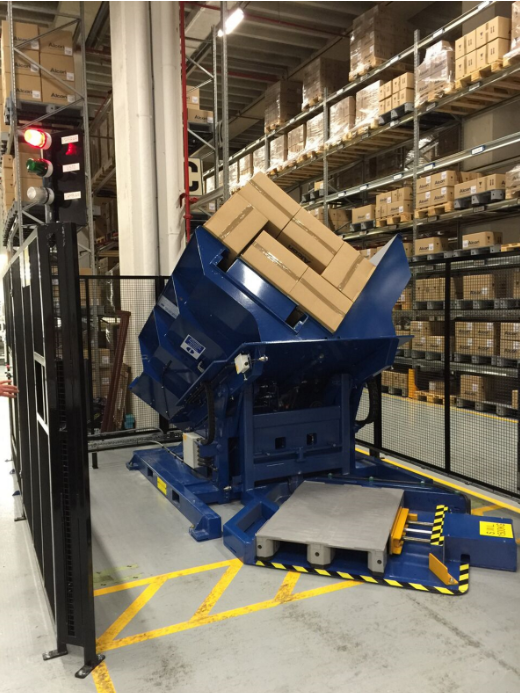
First, Analyze Your Load
This is the most important step. What, exactly, are you moving? Are they heavy steel coils? Bags of cement or chemicals? Boxes of sensitive electronics? The nature of your load determines everything.
- Weight: What is the absolute maximum weight of your heaviest pallet? You should always choose a machine with a load capacity that is at least 20% higher than your heaviest load to ensure durability and a long service life.
- Dimensions: What are the length, width, and height of your largest pallet load? The machine's opening, or "aperture," must be able to comfortably accommodate this size.
- Stability: Is your load a stable, solid block, or is it unstable, like a tall stack of bags or pails? A very unstable load might be better handled by a 90° tipper rather than a full 180° inverter to prevent shifting.
Match the Machine to Your Operation
Next, think about how the machine will fit into your daily workflow.
- Throughput: How many pallets do you need to process per hour or per shift? A small workshop that only needs to switch a few pallets a day might only need a basic, forklift-loaded model. But a large distribution center processing 50 pallets an hour will need a fully automatic, inline system that is fed by conveyors.
- Space: Where will the machine go? You need to measure your floor space carefully. Remember to account not just for the machine's footprint, but also for the space needed for a forklift or pallet jack to safely approach, load, and unload it.
Don't Compromise on Build Quality and Support
This is where I see people make mistakes. They focus only on the initial price. But the long-term cost of ownership is what truly matters. Look closely at the build quality. How thick is the steel? What is the quality of the hydraulic and electrical components? Who is the manufacturer, and do they have a good reputation for reliability? I always tell my clients, "You can pay for good engineering once, or you can pay for bad engineering forever in repairs and downtime." Ask potential suppliers about their after-sales support, the availability of spare parts, and their technical assistance. A cheap machine with no support is a future headache waiting to happen. A good supplier acts as a partner. They will help you with installation, training, and ongoing maintenance to ensure your investment pays off. This is the critical difference between a simple supplier and a true strategic partner.
My View: How can pallet inverters integrate into a fully automated system?
As a forward-thinking business leader, you are not just focused on solving today's problems. You are planning for the factory of the future. You rightly see automation as the best path forward, but it can be hard to visualize how individual machines, like a pallet inverter, fit into that bigger, integrated picture. Without a clear strategy for integration, you risk creating "islands of automation." These are highly efficient machines that are surrounded by inefficient manual processes. This situation severely limits your overall productivity gains and hinders your progress toward building a truly smart factory. The true power of a modern pallet inverter is unlocked when it stops being a standalone machine and becomes a communicating node in a fully connected, automated system. This is the direction the industry is heading, and it is where the biggest returns on investment are found.
Pallet inverters integrate into a fully automated system by physically and digitally connecting to other automated components like conveyors, Automatic Guided Vehicles (AGVs), and a central control software like a Warehouse Management System (WMS) or Manufacturing Execution System (MES). In this kind of intelligent setup, a pallet can be automatically transported to the inverter, have its pallet exchanged, and then be sent to its next destination—such as a shipping bay or an automated storage system—without requiring any direct human intervention.
The Connected Workflow: From AGV to Inverter to Conveyor
Let me paint a picture for you of how this works. An AGV picks up a pallet of finished goods from the end of your production line. Your central MES identifies that this specific pallet is damaged or that it needs to be switched from a wooden pallet to a plastic one for an export customer. The MES directs the AGV to deliver the pallet to an inline pallet inverter. The inverter, which is connected to the network, automatically performs the exchange cycle. Once complete, it releases the load onto an outbound conveyor belt. That conveyor then takes it directly to the correct truck loading bay, where it is loaded for shipment. This is not science fiction; this is the reality of Industry 4.0, and it is happening in advanced facilities right now. It is about creating a seamless, efficient flow of materials.
The Power of Data and IoT
This level of automation is made possible by data. Smart pallet inverters can be equipped with a variety of sensors that connect to the Internet of Things (IoT). These sensors can track key performance indicators like cycle times, count the number of pallets processed per hour, and monitor the health of the machine's components, such as hydraulic pressure or motor temperature. This data feeds directly into your MES or data analytics platform. You get a real-time view of your throughput. More importantly, you can implement a predictive maintenance strategy. The system can alert you that a component is showing signs of wear and needs to be serviced before it breaks down. This approach is fundamental to achieving goals like 95% equipment uptime. It transforms the pallet inverter from a simple piece of hardware into a data-generating asset that makes your entire operation smarter.
My Vision for the Future
When I started my career as an engineer, we thought automation was just about replacing a person with a machine. I now believe true automation is about creating an intelligent, self-regulating system. A pallet inverter is a perfect example of this evolution. It is based on a simple, powerful mechanical concept. But when you add sensors, data connectivity, and integrate it into your central factory control system, it becomes a smart device. It actively contributes to the overall intelligence and efficiency of your plant. It helps you lower costs, increase uptime, and make better, data-driven decisions. For any leader looking to build a world-class operation, this is the path to achieving the kind of operational excellence that defines the best companies in our industry.
Conclusion
Moving from manual handling to smart pallet inverters is not just an equipment upgrade. It is a strategic step toward a safer, more efficient, and future-proof operation for any facility.




